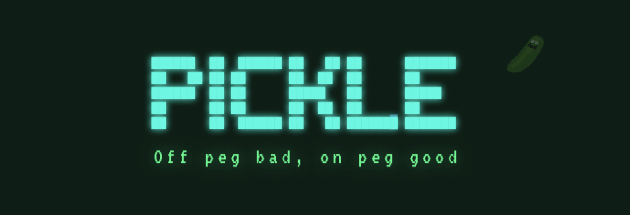

Understanding Pickle: a beginner’s guide and review
 Manny Reimi
Manny ReimiPickle Finance is one of the first farming protocol in the DeFi (decentralized finance) space. Curiously, for a so-called “food protocol”, its value proposition is completely original. Pickle aims to incentivize stablecoins to hold their peg. Besides technology and clever tokenomics, they also bring us plenty of fresh memes and Rick and Morty references.
In this article, we will go into the specifics and details of Pickle Finance and its diverse offerings. Moreover, we will learn how a two-day-old protocol earned the praise of none other than Vitalik Buterin himself, but probably not for the reason everyone thinks.
Okay, let’s continue with this guide on Pickle. We will be dipping (no pun intended) into the topic through the following 5 sections:
- Legitimacy
- Purpose
- Tokenomics
- Ecosystem
- Summary.
Legitimacy
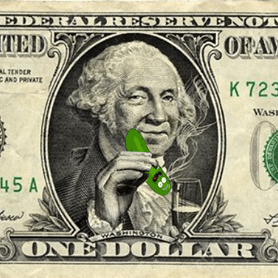
Pickle was founded by 4 anonymous developers, the most active of which is BigBrainBriner, which followers of the Pickle Finance Twitter are recommended to follow as well.
The team launched with a web application pickle.finance, a Medium post explaining the reasons behind Pickle Finance, and a one-page long lightpaper called the PicoPaper.
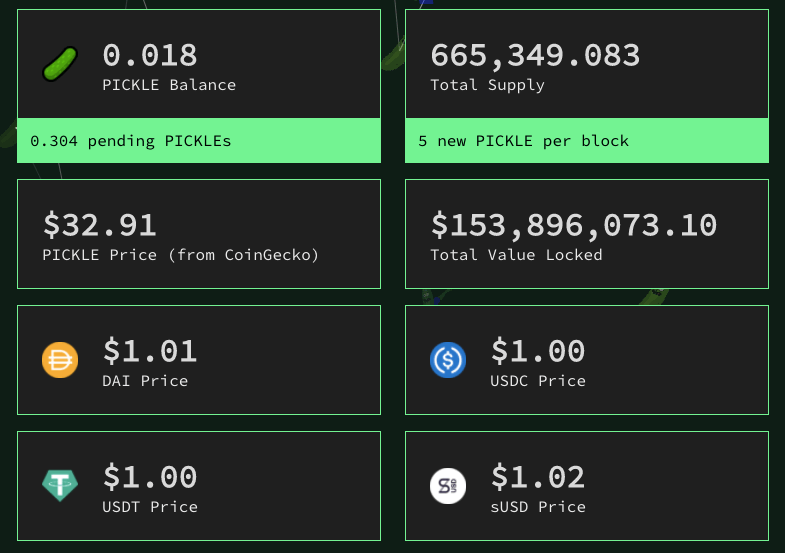
Currently, its contracts are unaudited, and the developers are only publicly known for moderating on the Pickle Finance Discord channel. To quell the impression that this could be a rug-pull (i.e. at least one of the devs could go the way of @NomiChef from SushiSwap), they have kept the smart contracts controlled by a multi-sig, and hold their devshare in$PICKLE only.
Curiously enough, the project received a boost by Vitalik Buterin only the second day after its announcement and launch. Vitalik was responding to the announcement by Pickle that the protocol would adopt quadratic voting, which we will explain in the governance section of this guide.
Albeit this was not an endorsement of the value proposition, tokenomics, or the integrity of the code by Pickle Finance, it was seen by many in the Ethereum community as a telltale sign that Pickle was not among the DeFi trend of making value out of thin air that Vitalik had complained about days prior.
Purpose
Off-peg stablecoins create instability and unpredictability in DeFi applications. Pickle Finance is an experimental protocol that aims to push stablecoins towards their peg by providing farming incentives to pump or dump one stablecoin for another. Since launch, Pickle Finance has had four stablecoins covered: $DAI , $USDC , $USDT , and $sUSD . Incentives paid in a new token called $PICKLE are paid to those who hold liquidity in these stablecoin pools vis-a-vis $ETH . Pickle calls this elastic farming incentivization, and it works as follows:
- If the stablecoins are below-peg then their pools receive more $PICKLE .
- If the stablecoins are above-peg, then their pools receive less $PICKLE .
The idea is that people will sell above-peg stablecoins for below-peg stablecoins, causing their prices to move towards their pegs.
The last use case is that of all stablecoins being above-peg, in which case, a pool of $PICKLE –$ETH would receive the most incentives.

Incentives are paid out to those who stake their Uniswap liquidity provider (LP) tokens in the Pickle farms, where they will start receiving
$PICKLE . Currently, Pickle supports all the above-mentioned stablecoin-ether pairs in Uniswap v2. Moreover, since the launch of $UNI , Pickle has responded with the creation of PickleJars or pJars. Each pJar acts as a vault for one of the $UNI -incentivized pools, which harvest-and-dump the $UNI at regular intervals, and exchange that value for more LP tokens (re-investing). The resulting asset can also receive
$PICKLE on the farm. There is a pJar for the $sUSD pool in Curve as well. These special vaults are available on the jars section of the app.
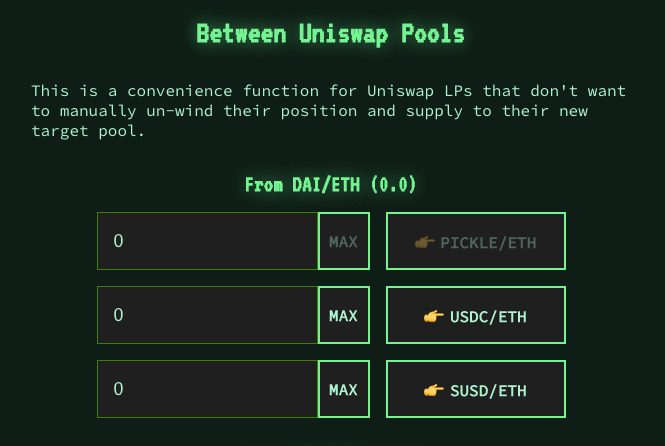
Another feature of Pickle Finance is its swap functionality. Pickle has created automations for migrating liquidity between the stablecoin pools of Uniswap and even from SushiSwap to Uniswap. This saves gas and time in taking advantage of the changes in incentives.
Tokenomics
The $PICKLE token is the tokenized incentive and governance token of Pickle Finance. Holding $PICKLE grants the right to vote on Pickle improvement proposals (PIPs)*. Although there is not a *decentralized autonomous organization (DAO) (e.g. “Pickle DAO”) at the moment, there is an active community and the core developers have implemented a handful of PIPs already.

Originally, the plan of the Pickle team was to mint 10 $PICKLE per block and to gradually bring it to 1.25 $PICKLE per block over the course of 4 weeks, and 1 $PICKLE per block thereafter, ad infinitum. Instead, at PIP-5, the $PICKLE rewards will reduce by 10% every week after the first four weeks, until the end of the first year. Thereafter, a steady-state will be reached with 1.29% annualized inflation. Of course, governance could change these incentives again.
Furthermore to its role as an incentive, the development team is currently building pVaults. These vaults are meant to utilize flash loans to leverage and arbitrage stablecoins in order to create further pressure to bring them to their peg while generating returns to be distributed to
$PICKLE holders. This, the team argues, will provide a more “fundamental” value to the token.
Besides farming $PICKLE , users can buy the token at secondary markets. All trading markets and pairs are available on CoinMarketCap.
Since $PICKLE is an ERC-20 standard token minted on Ethereum, it can be held in any ERC20 wallet that supports custom contracts like MetaMask, Trust Wallet, Pillar, Torus, and Portis. Most of these wallets can be secured with a hardware wallet like a Ledger.
A note about APY
APY (annualized percentage yield) in DeFi projects is a piece of core information for users to understand. Yield is often displayed annualized based on current conditions, even when those conditions are expected to change.
For example, APY on the $PICKLE –$ETH pool is based on the current rewards of 5 $PICKLE per block, even when these rewards are set to be halved in less than 2 days.
These yields are highly variable since rewards are a fixed amount of $PICKLE per block, the total value locked (TVL) will affect it. If the TVL goes up by 50% on that pool, the reward will be diluted in an inversely proportional manner, that is to say, by –33.3%. If the price of
$PICKLE goes down by half, the APY will halve, but in actual fact, you will suffer an actual loss of –25% of your capital in the pool (each paired asset is half-weighted in Uniswap) plus an impermanent loss of –5.719%, so a total loss of capital of –30.719% + a loss on the future value of the investment since the reward has gone down. This will be offset by the trading fees earned during the period, which will be based on the trading volume, the trading fee, and your stake in the liquidity pool.
The best way to estimate return-on-investment (ROI) is to understand the investment, convert the APY into a more manageable timeframe (for DeFi, daily yield should work in most cases), and understand the assumptions. You may be able to model the interest under various scenarios for each variable in the equation. Since the APY is calculated as a linear function, dividing it by 365 gives you a daily yield, and by 52 a weekly yield, and by 12 a monthly yield.
Keep in mind, the investment could be compounded, either automatically, or manually, resulting in a vastly different ROI than the APY. Either understand how compound interest works, or get hold of a financial calculator.

For example, at 1,000% APY, we get a daily yield of 2.74%, if it is linear and stable throughout the whole year (big if), the end result will be a 1,000% or an 11x change on the principal. If compounded monthly, weekly, or yearly, will be a very different result, as follows:
In fact, these numbers are so comical, at some point your own re-investing would significantly dilute the rewards. 1,000% APY is unlikely to be sustained for a year. Even 1% daily yield that can be compounded daily leads to an amazing 37.8x yearly ROI.
Keep in mind that transaction fees may also affect your deposit, compounding, and withdrawal strategies. In extreme cases, transaction fees like high gas prices will render your gains meaningless or cause you losses.
Do not play around with money that you do not have or cannot afford to lose, or with investment products or strategies that you do not understand.
Ecosystem Governance
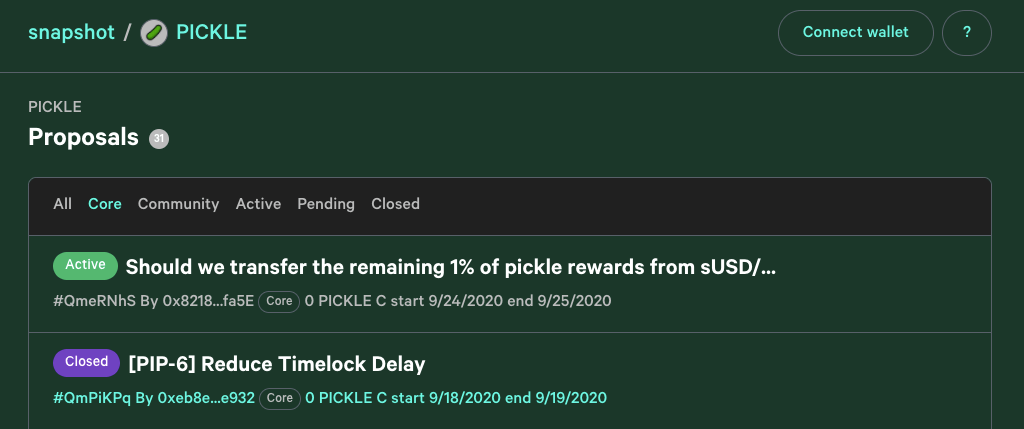
You can find BigBrainBriner, and the rest of the community being very active in many channels. The community consists of liquidity providers (LPs) in Pickle farms, traders and $PICKLE hodl-ers, and other developers who make suggestions or want to build on top of Pickle. Once a discussion on a new initiative reaches a certain degree of clarity, it is proposed on the Pickle Snapshot. There, it can be voted by the community using snapshot-based gasless voting.
Under the quadratic voting model, the square root of a user’s $PICKLE holdings are taken as a voting metric called PICKLE C. This means that a user with 100 $PICKLE and 10 users with 1 $PICKLE have the same voting power. Of course, a whale may still game the system by distributing their
$PICKLE across several wallets to avoid being “square-rooted”, but this system will at least slow them down and cost them gas to spread out their
$PICKLE like so. The team is looking to develop a solution to keep $PICKLE as democratic as possible.
In Summary

Pickle is probably the most interesting “food project” out there, with a refreshing approach and a great speed of execution. Surely, there are risks in DeFi, and Pickle is no exception, with anon devs and unaudited contracts. Still, Pickle is not a fork, not a clone, and isn’t vampire- or zombie-attacking any high visibility VC project due to an anti-elitist anon crusade. While the tokenomics model must mature in order for the project to become a mainstay of DeFi, I give them plenty of kudos for their originality.
Excited about Pickle? Anything this article missed? Reply below to let me know!
Recommended to Read Next
https://holdex.io/c/learn/understanding-curve-a-beginners-guide-and-review
https://holdex.io/c/learn/trading-vs-yield-farming-making-money-with-defi-basics
https://holdex.io/c/learn/yield-farming-concepts-making-money-with-defi-basics
#defi #guides #tokenomics #review